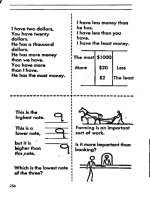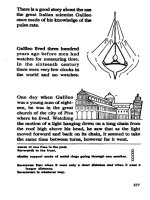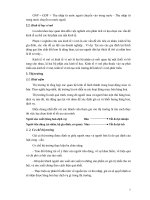101 Marketing Strategies Phần 2 potx
Bạn đang xem bản rút gọn của tài liệu. Xem và tải ngay bản đầy đủ của tài liệu tại đây (276.48 KB, 29 trang )
Action Needs Vision
Many professionals begin their plans with the action steps. This is
a huge mistake. When you begin your plan with the action
steps, you will not have the motivation to carry out the steps.
Having a firm grip on a solid and important vision will provide
the motivation to keep going when circumstances weaken your
drive.
Remember, though, all plans are dynamic, not carved-
in-stone documents. Be prepared to reach for unexpected
opportunities. All plans begin with intended strategy. But cir-
cumstances will prove that certain actions do not work. Other
circumstances will give rise to opportunities you did not con-
sider. With a dynamic plan, your realized strategy will be a
happy ending.
Summary
Remember that marketing is an investment activity. What you
do with your billable time determines your income this year.
What you do with your marketing is an investment in your fu-
ture income. As part of your marketing plan, clearly set forth
the amount of time and dollars you are willing to invest. Make
sure the amounts invested make sense as related to your in-
tended result.
Finally, it’s not what you know about marketing or what you
plan to do about marketing that counts. It is your commitment
to marketing action that will achieve results for you.
Note: See Appendix A for an outline of a sample marketing plan
items.
101 Marketing Strategies
8
Waugh 01 2/4/04 10:31 PM Page 8
4
Motivating Employees for
Marketing
D
o you want better sales results from associates? A partner
told me recently, “We’ve had a bonus plan for years and no
one seems to care.” If this is true of your firm, perhaps it’s time
to rethink your compensation plan.
If you pay staff members a flat salary for hours worked, then
you will get just that: hours. An imaginative bonus plan will stim-
ulate employees to help attract and retain clients.
Finding and retaining loyal employees is one of the secrets
to marketing success. When you create pay plans that are imag-
inative and fun, and when you can tap into other motivators
such as recognition and family support, you will keep your best
people and keep them excited about their work. They can also
help you recruit more people like them.
I have researched this concept thoroughly over the past few
years with many firms and other consultants. We have found five
characteristics of incentive pay plans that create success.
Reward for Effort
Jay Conrad Levinson says it takes an average of 27 marketing at-
tempts to move a prospect to readiness to engage. Keeping mo-
mentum in a long sales cycle is important, but difficult. No
wonder most people give up after the second or third attempt.
It is the cumulative effect of repeated marketing efforts that
yields new clients. Firms that reward effort create an environ-
ment that encourages staffers to build relationships that can pay
off in the long term.
Introduction
9
Waugh 01 2/4/04 10:31 PM Page 9
Rewarding effort need not break the bank. Let your associ-
ates know that at least half of their bonuses and raises depend
on marketing efforts.
Reward the Results Your Associates Can Control
Don’t wait for the client to pay the bill. Pay for creating the lead.
Pay them even if the lead does not become a new client. Initiat-
ing introductions to qualified prospects is a valuable habit for
you to support.
Pay bonuses for regular attendance at civic and business
club meetings.
Make Rewards Timely
Quickly reward the effort and results you want repeated. Again,
don’t wait till the client pays. Quick rewards encourage more
action.
Reward Publicly and Often
If you can pass out bonus checks regularly at staff meetings, you
will create excitement. When you reward publicly, you are em-
ploying a more powerful motivator than money: recognition.
Being recognized by one’s peers for a job well done is more
long-lasting than money.
Reward with Products, Vacations, or Entertainment
Products such as televisions or trips are remembered long after
cash has been spent. When you reward with tangible items you
impact the employee longer and you may positively affect his or
her spouse.
101 Marketing Strategies
10
Waugh 01 2/4/04 10:31 PM Page 10
5
Eight Ways to Build Your Firm Over
the Next 12 Months
I
s this going to be your year for turning on the power of mar-
keting and sales in your business? If your answer is yes, here
are eight keys to success:
1. Focus on the Client’s Profits, Not Your Own
There is a limited demand for routine tax return prepara-
tion services or will preparation, but there is unlimited de-
mand for professionals who help clients improve profits!
2. Don’t Hibernate During Compliance Season
Clients are never more interested in help with their busi-
ness than when confronted with last year’s financial results
or with their tax liability. Plan now for cross-selling to each
client you meet with during this filing season. Augment the
effort with preprepared press releases, articles, and mail-
ings.
3. Build Relationships with Your Clients’ Team Members
This year, plan to meet with your top 10 clients’ other pro-
fessionals. These people are the movers and shakers in
your community. By creating a team working for your
client, you will also have created a referral team that works
for you.
4. Develop a Unique Selling Proposition, and Quit Talking
about Fees
When meeting with prospects, focus on the value you can
offer, and on what makes you different from your competi-
tors. Fee terms should almost be an afterthought.
Introduction
11
Waugh 01 2/4/04 10:31 PM Page 11
5. Learn to Ask Better Questions
Knowing how to ask good questions is the foundation of
being an effective advisor. Through questioning, you learn
what you need to know to help your clients.
6. Help Clients Prepare for the Future
Clients are more interested in today and tomorrow than
they are in yesterday. Help your clients use your services as
a foundation for making better judgments and business de-
cisions.
7. Prepare a Services Matrix
Prepare a matrix of your largest clients and services used.
Probably 5% of your clients (including families and con-
trolled groups) make up over 50% of your revenue. Use
the matrix to determine your best opportunities.
8. Always Give More Than You Promise
Always exceed your client expectations by 1% and you will
have a continuous flow of delighted clients. Sometimes,
under pressure, you may promise delivery of a report be-
fore it can realistically be done. Learn to manage expecta-
tions by promising the outside date, not the earliest. Then
deliver earlier.
101 Marketing Strategies
12
Waugh 01 2/4/04 10:31 PM Page 12
13
CHAPTER
TWO
Prospecting
6 Consultant’s Advice Spells Disaster:
Instead, All Strategy Begins with the
Market
7 Turning Prospects into Clients
8 The “R” Word . . .
9 The Seven Deadly Sins of Prospecting
10 Trade Shows Can Create Good Leads
11 Broad-based Marketing Supports
Prospecting
12 Tip Clubs
Waugh 02 3/22/04 10:43 AM Page 13
Waugh 02 3/22/04 10:43 AM Page 14
6
Consultant’s Advice Spells
Disaster: Instead, All Strategy
Begins with the Market
I
had the challenge of working with a large firm whose growth
had flattened out during the preceding three years. (In con-
trast, in the previous five years the firm had experienced dou-
ble-digit growth.) Owner earnings in the most recent two years
had decreased. During our strategic assessment process, I
learned that the firm had engaged a well-known strategic plan-
ner prior to the three-year decline and had followed his advice.
“Standard” Advice for Squeezing Profits and Quality
What advice had this planner given the firm? It boiled down to
this:
• In order to improve partner earnings, you should increase
partner charge hours.
• Decrease the hiring process and focus on high chargeable
hours from your staff.
• Use technology more to help reduce the size of the admin-
istrative staff. Instead of one administrative person for every
owner, reduce it to one for every three.
• Delay investments in technology to replace systems every
five years rather than every three.
• Bring all training in-house.
This highly regarded strategic planner had given the firm a
plan for disaster. Short-term profits were squeezed from train-
ing, technology, and marketing. Within only three years, the
prospect pipeline dried up and the owner’s computer network
Prospecting
15
Waugh 02 3/22/04 10:43 AM Page 15
had become “clunky” compared to what was now available.
While owner profits soared for two years, by the third year prof-
its began to slide as the owners worked harder than ever.
The owners were now looking inward, rather than out to the
market.
Work with the Market
Successful strategic planning should always begin with the mar-
ket outside the firm, not the internal processes inside the firm.
Yet, when owners retreat to discuss strategic plans, the agenda
items frequently include staff evaluations, raises and bonuses,
owner compensation, admission of new owners, the financial
results for last year, the budget for next year, new office space,
recruiting efforts, and other issues that do not fall into true
strategic planning.
Conclusion
Just as your “market” is more than your clients, strategy must be
more than a way to get more profits in the short-term. Strategy
should focus on building the balance sheet of your firm so prof-
its will be strong for the long term. When setting the agenda for
your firm’s strategic planning session, first start with the market,
then look internally.
101 Marketing Strategies
16
Waugh 02 3/22/04 10:43 AM Page 16
7
Turning Prospects into Clients
G
ood marketing programs create many prospects. But all
prospects do not—and should not—convert to clients.
Here are ideas to help you convert prospects into clients.
Take Action Immediately
Not immediately following up with prospects causes them to go
cold. Then you are right back where you started. The prospect
will likely forget meeting you. Or, the prospect may think you
are not interested in serving her. Furthermore, your response
time to a lead’s request is an indication of your response time
when he is a client. So take action quickly when you receive a
telephone inquiry, a trade-show lead, a referral, or other lead.
Focus on Referrals
Referred prospects are the most valuable. When you receive a
referred lead, the selling has already been done. If you act
quickly on referred leads, it will reflect well on your source, and
he will be inclined to refer you again. If you delay on a referred
lead or handle it poorly, don’t expect to receive any further
leads from your valuable referrer.
Evaluate the Lead
Some follow-up on every lead is a good idea. You want to sepa-
rate the suspects from the prospects. Evaluating the lead will en-
able you to follow up more quickly with the better prospects.
Ask the lead or the referral source about problems, needs and
Prospecting
17
Waugh 02 3/22/04 10:43 AM Page 17
wants, the decision process, and his or her ability to pay your
fees. Ask these questions as early in the process as you can.
Have a Follow-up Plan
An automatic follow-up system will make it easy for you to follow
up in the same way every time.
Set aside a definite time for contacting and courting a new
prospect. Unless you set aside time in your calendar, you may
have trouble fitting it in. Prospect value can dissipate rapidly. If
you are fully booked, fire off a letter or call the lead to set a spe-
cific time to meet.
Add the Prospect to a Mail List
Every professional should have a marketing database. When
you obtain a lead, the information should be permanently
recorded in your database. “A” prospects should receive regular
and personal attention, whereas “C” prospects can be handled
by mail. (Handling of “B” prospects can depend on your load.)
Give the Prospect to Someone Else
If you cannot follow up the prospect, or if the lead is of little in-
terest to you, give it to someone else in your firm. Selling is a
team effort. Ask your designee to keep you informed as to the
progress of the prospect. Offer to help when the prospect gets
close to closing.
Conclusion
A pipeline full of good prospects is critical to the steady growth
of a firm. A full pipeline enables you to be selective and to fol-
low up with the best leads.
101 Marketing Strategies
18
Waugh 02 3/22/04 10:43 AM Page 18
8
The “R” Word . . .
R
ejection isn’t really rejection unless you accept it as final!
Much research has shown that moving a prospect from
contact to contract will take about nine positive marketing in-
teractions with your firm. You might think of the first eight at-
tempts as rejections, but they’re not. The reality is that many of
your attempted interactions are missed by your prospects. And
just because they don’t buy now doesn’t mean they won’t later.
Ross Perot said it took him 68 sales calls before he made his
first sale for EDS in 1962. He built two major companies in the
process. Colonel Sanders (KFC) didn’t sell a “franchise” until
he’d talked to over 1,000 restaurants.
When a prospect doesn’t hire you early, he is not rejecting
you. People have different circumstances and different timeta-
bles for making decisions.
You Can Deal With “Nonsuccess”
A technique to help you overcome the fear of rejection is: Don’t
go for the kill on the first call. Set the objective for the first in-
teraction at a very low level, maybe just creating awareness. If
you can then build each successive call into a gradual sales strat-
egy, then your fear of rejection won’t stop you.
Another technique is planning your response to rejection.
Your contact may have a rational reason for not doing business
with you right now. Your contact may be having a bad day and
her lackluster response is not your fault.
Prospecting
19
Waugh 02 3/22/04 10:43 AM Page 19
Persistence Pays
A steady, consistent approach will win out every time. The aver-
age sale in American commerce is made on the fifth sales call,
but the average professional makes only two or three calls. Be-
cause the buying cycle is long and unpredictable, the average
professional services sale may take over a dozen contacts. Yet
many professionals let their fear of rejection keep them from
ever getting started!
Professionals are trained to avoid making mistakes. How-
ever, when you view marketing as a numbers game, the impact
of rejection will be less. The feeling of rejection you have when
someone does not hire you immediately can be depressing.
However, if you approach the market with the realization that
over 90% of your marketing activity will not pay off today, you
gain a more realistic perspective.
Summary
Remind yourself that marketing that is not successful today can
be successful tomorrow. Activity will help build a good client re-
lationship. Engage in positive self-talk and separate your ego
from the sale. When you can accept temporary nonsuccess, you
will be a stronger professional who can market.
Last, maintain a healthy balance between positive client in-
teraction and new prospect activity. The client relationships will
enable you to be confident with prospects.
101 Marketing Strategies
20
Waugh 02 3/22/04 10:43 AM Page 20
9
The Seven Deadly Sins of
Prospecting
L
ooking for new clients needs to be a regular and ongoing
effort. No matter how good your retention rate, there will
be some attrition and need to upgrade your client base.
Prospecting is much like exercising or practicing your golf
swing. Until your business goes flat you aren’t aware of the ne-
glect. Here are the seven deadly sins of prospecting. Avoid them
like the plague:
1. No System for Prospecting
Most professional firms have systems for paying the bills
and systems for collecting accounts receivable. Every firm
needs a system for collecting, and following up on
prospects.
2. No Qualifying of Prospects
Prospects who are interested, but who are not qualified to
do business with you, will waste your time and your money.
Qualify the prospect by asking the questions necessary to
ensure the prospect will make a profitable client.
3. No Consistency in Prospecting
Successful prospecting requires discipline. Professionals
tend to prospect heavily at the same time all their competi-
tors are prospecting. Consistent prospecting systems will
help you build on the power of compound impressions
and on being in front of prospects when they are ready to
buy.
Prospecting
21
Waugh 02 3/22/04 10:43 AM Page 21
10
Trade Shows Can Create
Good Leads
W
illie Sutton had the right idea. Asked why he robbed
banks, the infamous bandit replied, “Because that’s
where the money is.”
Prospecting for leads isn’t quite as easy as finding money in
a bank. But if you’re seeking to fill your sales hopper full of
good prospects, it makes sense to exhibit at an industry trade
show.
Here are a few pointers to help you make your trade show a
winner.
Focus on the Result
You want to end up with new clients as a result of your trade
show activity. Realistically, the trade show encounter is only the
first step in about nine marketing interactions that you should
plan with a new prospect BEFORE he or she will engage you.
Coming away with good leads often requires you to evaluate
the trade show’s potential for generating the right leads. Ask
the show promoter for a list of last year’s exhibitors and call two
or three of them to find out the “rest of the story.”
Rarely will your attendance at a show result in immediate
business. According to Kathryn Clark, writing in Personal Selling
Power magazine, “two thirds of all sales from trade shows aren’t
achieved until 11 to 24 months after a show.” So set a realistic
expectation for lead generation.
Prospecting
23
Waugh 02 3/22/04 10:43 AM Page 23
Know What Types of Leads You Want
Before you attend the show, decide what type of lead you will
seek. For example, when you attend a trade show for your pri-
mary industry niche, the attendees at the show may be your pre-
determined targets. Other times, at a general business exhibit,
the exhibitors themselves may be your targets.
Every time you meet someone at the trade show, attempt to
qualify him or her as a potential prospect. Ask planned ques-
tions that will enable you to follow up appropriately after the
show. Ask pertinent questions about their current provider,
such as: Has your professional helped you be more profitable?
Has your accountant helped you deal with new technology? Has
your attorney helped you with business advice?
When you plan your trade show booth, consider a unique theme
that will attract potential prospects. We recently did a plant shop
theme where we decorated our booth like a florist shop and used the
motto “We help you grow your business.” Our giveaway was a
small plant with our logo on the planter. Many attendees stopped
at our booth just because it was different. We have a reputation for
changing our theme each year, so many attendees actually search
our booth out. The lesson here is to differentiate yourself! (We also
won an award for this idea at the 2002 Association for Account-
ing Marketing convention.)
—Deborah Bailey Browne, Partner with Vanacore,
DeBenedictus, DiGovanni & Weddell
Conclusion
If you are well prepared, trade shows can be an effective vehicle
for professionals who are willing to reach out to people in a
show environment.
101 Marketing Strategies
24
Waugh 02 3/22/04 10:43 AM Page 24
11
Broad-Based Marketing Supports
Prospecting
M
ass media (radio, TV, national publications) reach a large
number of people, most of whom aren’t potential clients.
Rather, you should be very targeted with your selection of
media and try to achieve personal contact as soon as possible.
Advertising and Public Relations
Advertising and public relations are usually best when included
in targeted trade or industry publications. Advertising is an ex-
pensive technique for attracting prospects. Only those firms
whose marketing is sophisticated and mature will benefit from a
significant advertising budget.
Smaller firms and professionals are better off focusing on
public relations for media exposure. Writing articles for your
trade journal or business newspaper is a good way to become
known in a community of prospects. Readers generally perceive
an article to be five times more believable than advertising.
Public relations can also be executed in the form of press re-
leases, sponsorships of events, speaking opportunities, and
other activities.
Newsletters
Targeted direct mail is usually very effective because the print
media can be directed at your best prospects, clients, and refer-
ral sources. Newsletters are a form of direct mail that contains
professional advice, observations, and comment. Regular
Prospecting
25
Waugh 02 3/22/04 10:43 AM Page 25
newsletters keep your name in front of your prospects and re-
mind them to contact you when a need arises. Specialty trade
newsletters attract the serious reader to do more than recognize
your name. Firms that write their own newsletters have excel-
lent client responses. But the publication process can be daunt-
ing. So most firms use some form of prepackaged newsletter
program. Practice Development Institute, Chicago, and M. Lee
Smith, Nashville, are the leading publishers of newsletters for
accountants, lawyers, and financial advisors.
Websites
Most people in today’s modern world receive much of their in-
formation electronically through television, radio, and the In-
ternet. It makes good sense to have a website. Your website can
take the form of an electronic brochure, with articles and other
credibility builders. People who are interested in you will check
out your website. If it is good, a favorable impression can be
made before meetings. If it is not good, you might have diffi-
culty gaining serious interest.
Conclusion
Services are bought and sold by personal contact. Broad-based
marketing should be designed to create it.
101 Marketing Strategies
26
Waugh 02 3/22/04 10:43 AM Page 26
12
Tip Clubs
A
ny time you network with other people, you can get a busi-
ness lead or referral. For instance, industry associations
can work as tip clubs if you make the effort to network. How-
ever, specific groups called tips groups or clubs have been cre-
ated for members to give other members leads and referrals.
There are many variations on tips groups, but generally you
attend weekly and bring in a lead for someone else in the
group. Groups typically limit membership to one of each type
of business so that there is no competition. This means there
may not be an opening in established groups if they already
have an accountant or attorney.
Start Your Own Group?
Stockbrokers, insurance agents, bonding agents, bankers, and
many other professionals are looking for referrals. Consider
forming a “tip” or “lead” group. You could ask a bank trust offi-
cer, a computer vendor, an insurance broker, a commercial real
estate developer, and other compatible professionals to join
your club.
Think about your clients first as potential members, then
their service providers and bankers. While groups usually have
20 or so members, even a very small group can work if you get
people who bring you regular leads.
Existing Franchises
If you don’t want to start your own group, there are many
groups available, including franchises (Business Network Inter-
Prospecting
27
Waugh 02 3/22/04 10:43 AM Page 27
national, Le Tip, Leads Club) and groups run by your local
Chambers of Commerce.
Conclusion
You can often find existing tips groups listed in your local news-
paper business calendars. Such groups can give you a structure
to improve your prospecting and referrals many times over.
101 Marketing Strategies
28
Waugh 02 3/22/04 10:43 AM Page 28
29
CHAPTER
THREE
Qualifying
13 Big Hat, No Cattle
14 NEAD-PAY
15 Too Busy to Grow?
16 Use the “David Letterman” Dismissal
for Unqualified Clients and Prospects
Waugh 03 2/4/04 10:32 PM Page 29
Waugh 03 2/4/04 10:32 PM Page 30
13
Big Hat, No Cattle
T
exans call people who live the life of the rich and famous,
without real wealth, “big hat, no cattle.” Take notice of the
people with whom you are networking. Do they have the re-
sources to pay your fees and grow with you or are they “big hat,
no cattle?”
In The Millionaire Next Door, authors Thomas J. Stanley and
William D. Danko assert that the typical millionaire has a boring
business and can be met in a trade association. Most million-
aires do not flash their wealth. Rather, the authors found, “Peo-
ple who look like they are living the good life may not have
much wealth.”
Finding Wealthy Prospects
The book points out that very often those who supply the
wealthy become wealthy themselves. The authors state, “There
are significant opportunities for those who target the affluent,
the children of the affluent, and the widows and widowers of
the affluent.” They estimate hundreds of billions of tax dollars
will be paid to the federal government during the next 10 years.
Professionals advising families and serving estates will earn
huge fees to help conserve as much wealth as possible.
The science of qualifying starts with the segment of the mar-
ket you select for networking and communicating.
Segmenting your market into least likely, possible, and most
likely categories will assist you in deciding where to invest your
networking time. Prospecting a target-rich segment of the mar-
ket just makes good sense.
Qualifying
31
Waugh 03 2/4/04 10:32 PM Page 31
Stanley and Danko’s research is comforting news for profes-
sionals who are networking in trade associations. They sent out
3,000 questionnaires to affluent Americans and conducted
about 100 in-person interviews. Their findings build on some of
Stanley’s earlier research, published in his book Marketing to the
Affluent. About two thirds of working millionaires are self-em-
ployed and own mundane businesses like scrap metal, welding,
highway construction, and dry cleaning.
The wealthy list their CPAs and attorneys as their trusted
business advisors. The millionaires list tax shelters, disciplined
investing, and extreme thriftiness as keys to their amassing real
wealth.
Conclusion
How can you profit from the advice in this book? First, make
one of your priorities to aggressively network with your affluent
clients and acquaintances. If necessary, give up time you are
spending with less-promising clients. Second, pay attention to
the next generation of owners of your clients’ businesses. When
the business ownership and management changes, you don’t
want them changing professionals.
Third, become involved in an industry trade association.
Most affluent business owners value their trade associations
above all other organizations. Fourth, become an advocate of
the wealthy. Write your senators and legislators on matters that
can help your clients. (Send a copy of letters to your affluent
prospects and clients with a note saying, “This is an issue that
probably affects you.”)
101 Marketing Strategies
32
Waugh 03 2/4/04 10:32 PM Page 32
14
NEAD-PAY
NEAD-PAY is an acronym (slightly misspelled) for a pattern of
asking qualifying questions. When you religiously follow this
pattern, you will have a good idea about the prospect’s qualifi-
cation to do business with you.
N stands for Now. Ask the prospect “Who are you using now
for your advice?” The answer to this question tells you the
names of your competition and perhaps the names of other ad-
visors. When you know the names of the entrenched competi-
tor, you may have some idea about their reputation, clients, and
personnel. Another question to ask might be, “What are you
doing now about your legal protection (or your tax situation)?”
E stands for Enjoy. Ask the prospect, “What do you enjoy or
like about your present accountant or lawyer?” Or ask it another
way: “Do you feel good when you are working with your profes-
sional?” or “What do you like most about X?” When you ask
questions about what is good about your competitor, you relax
the prospect. You also may receive some insight into the next
question.
A stands for Alter. Ask the prospect, “What would you alter
about the service you receive?” Or you could ask, “If you had the
perfect relationship with your professional, what would you alter
to make you perfectly happy?” Prospects’ motivation to change
to you is created by your making them dissatisfied with the sta-
tus quo.
D stands for Decision. Ask questions about the decision
process, the decision makers, and the decision criteria. Questions
like, “Who, besides you, is involved in the decision to hire a law
firm?” Or, “The last time you changed accountants, how did you
go about the process?”
Qualifying
33
Waugh 03 2/4/04 10:32 PM Page 33





![[Điện Tử Học] Ngắn Mạch Hệ Thống - Pgs.Ts.Lê Kim Hùng phần 2 potx](https://media.store123doc.com/images/document/2014_07/13/medium_awg1405243256.jpg)
![[Nông Nghiệp] Trồng Xoài, Na, Đu Đủ, Hồng Xiêm - Gs.Ts.Trần Thế Tục phần 2 potx](https://media.store123doc.com/images/document/2014_07/13/medium_nrz1405268444.jpg)

![[Điện Tử] Tự Động Hóa, Tự Động Học - Phạm Văn Tấn phần 2 potx](https://media.store123doc.com/images/document/2014_07/14/medium_ilz1405275656.jpg)
